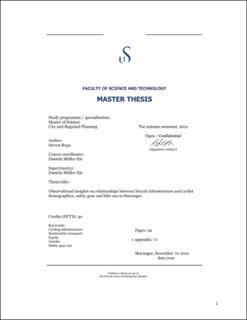Observational insights on relationships between bicycle infrastructure and cyclist demographics, safety gear and bike use in Stavanger.
Master thesis
Permanent lenke
https://hdl.handle.net/11250/2988673Utgivelsesdato
2021Metadata
Vis full innførselSamlinger
- Studentoppgaver (TN-ISØP) [1459]
Sammendrag
Norway has ambitious plans to reduce private car use, both for the benefits of reduced emissions and tomitigate their space consuming impacts on roadways and in cities. In conjunction with these plans, a hightarget has been set for increased bicycle mode share across Norway’s major urban regions. In Stavanger thishas translated into increased investment in the facilitation of cycling for transport, including the expansionand improvement of bicycle infrastructure. Although, what cyclists perceive as safe and attractive bicycleinfrastructure can vary widely, based on factors such as experience level, age and gender. One example is,that a stronger preference towards infrastructure with a greater level of separation between motorizedvehicles and cyclists, has been found in both women and older adult cyclists.
Through observations of cyclists at twelve locations and three different infrastructure typologies inStavanger, this thesis seeks to provide insight on the possible influence of bicycle infrastructure on theproportion of cyclists of different genders and age groups. The proportion of cyclists which use safety gear,sport clothing and e-bikes are also a focus of the analysis. These variables are of relevance, as research hashighlighted that cities which have safer and more separated infrastructure, often also have more normalizedcycling cultures and cyclists which less often use safety gear and sport clothing. While e-bike users often havedifferent infrastructure preference and choice than that of conventional bike users.
The infrastructure typologies which are compared, have been selected on the basis of the degree that theyare separated from motorized vehicles. Although other infrastructural and environmental characteristics arealso considered, including traffic volume, traffic speed, measure of centrality and density. The findings donot validate the assumptions made between the infrastructure characteristics of degree of separation andthe variables considered. Although strong correlations are found between measures of traffic intensity andcentrality at observation points and the proportion of women cyclists using the infrastructure. While otherfindings may point to a moderating effect of e-bikes on the proportion of women cyclists observed at morehighly trafficked locations. Additionally, correlations between safety gear and sport clothing use andcentrality are found which could be potentially related to two distinct types of cyclists found in Stavanger.
